In the late seventeenth century when the Mughals still held tight the reins of power in Bengal, Job Charnock, the staunchly loyal servant of the East India Company landed in a small swampy village called Sutanuti in Bengal. He was sent as an agent to set up a trading post for the English in the region. After much squabbling and heated negotiations with the Nawab and zamindars, Charnock established his factory at Sutanuti. A few years later, in 1690, he persuaded the company to set up its headquarters in Bengal, which by then was a thriving trading outpost, popular among the Armenians, Portuguese, Chinese, Jewish as also native traders and buzzing with their entrepreneurial spirit.
Thus lay the foundation of Calcutta that was marked by a distinct European flavour, thousands of Englishmen teeming across the streets and grand overarching neoclassical buildings sprouting all over the landscape to announce loud and clear the monopoly of English trading interests in the region. The economic enterprise of the Company soon found a means to establish force when Fort William was built and declared the seat of Presidency in 1706. Encouraged by the growing security provided by the Company, investments flowed in from Englishmen, other Europeans and also the native elite.
Located in the heart of present day Kolkata is a vast lake that is locally referred to as the Lal Dighi. Legend has it that the lake got its name from the fact that the Bengalis would celebrate Holi on its banks which would eventually result in the lake turning red. There are other theories though for its name, a popular one being the fact that the lake reflected the red walls of Fort William that lay right beside it. Back in the 18th and 19th centuries, Lal Dighi formed the nucleus around which the English built their administrative buildings, business houses, religious centres and recreation facilities.
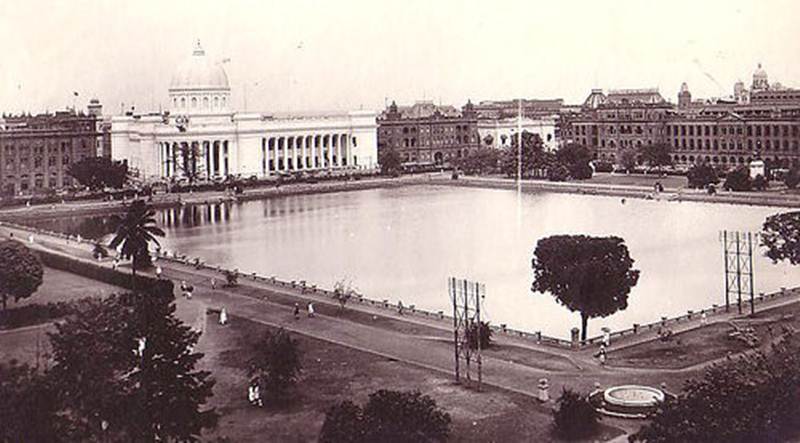 Lal Dighi, Calcutta 1910 (Wikimedia Commons)
Lal Dighi, Calcutta 1910 (Wikimedia Commons)
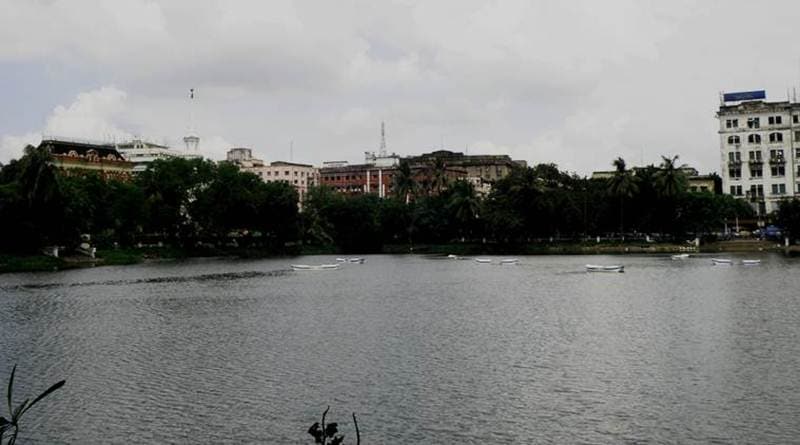 Lal Dighi, Kolkata 2017 (Express Photo/Adrija Roychowdhury)
Lal Dighi, Kolkata 2017 (Express Photo/Adrija Roychowdhury)
Today 70 years after the British left the country, and 106 years years after they shifted capital from Calcutta to Delhi, the area still houses some of the most extraordinary, elaborate architectural pieces that were once built by the Europeans with the intention to turn Calcutta into a Victorian delight in contrast to the abode of the natives who they resolutely wanted to keep apart and intimidated. At present, these same works of British grandiosity are the places from which the Mamata Banerjee-led Bengal government exercises its administrative authority. Alternatively, several of these structures also house modern day banks and small business houses.
The Writers building
The northern side of Dalhousie square, right across the Lal Dighi, is the Writers’ building, the ornate red brick structure that for a long time has been perhaps the most important edifice in Kolkata. In 1776, when it was first built, the building turned out to be the first three-storeyed structure in the city, meant to be a dwelling place for junior officers (writers) of the company, typically those receiving a salary of less than Rs. 300 a month.
 A plain stuccoed building with a collegiate system of living is what best describes the original Writers building. (Wikimedia Commons)
A plain stuccoed building with a collegiate system of living is what best describes the original Writers building. (Wikimedia Commons)
However, the original plan of the building was such that it lacked any kind of architectural beauty. A plain stuccoed building with a collegiate system of living is what best describes the original Writers building. In 1882 though, the structure underwent a massive change with baroque statuary being introduced at the top and a Graeco-Roman style of architecture being added.
 In 1882 though, the structure underwent a massive change with baroque statuary being introduced at the top and a Graeco-Roman style of architecture being added. (Wikimedia Commons)
In 1882 though, the structure underwent a massive change with baroque statuary being introduced at the top and a Graeco-Roman style of architecture being added. (Wikimedia Commons)
When the British left the building became the house for the secretariat of the West Bengal government. At present though, the secretariat has been shifted to a building named Nabanna in Howrah and what remains is a torn down facade that is undergoing renovation since October 2013. Although a part of the structure still retains its beauty of Corinthian architecture, standing as a symbol of power.
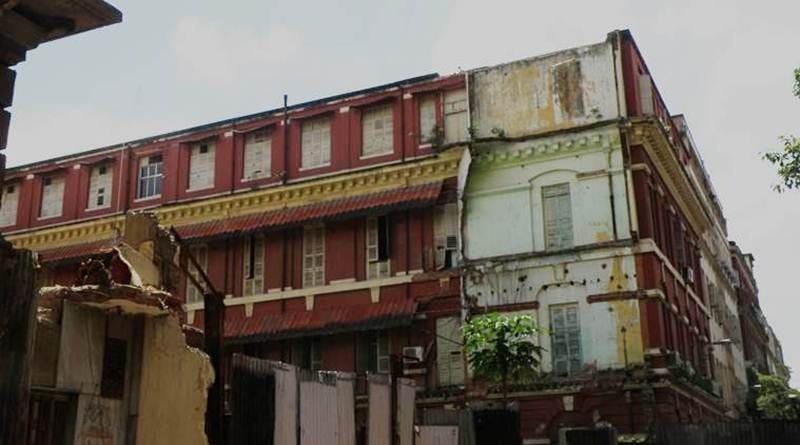 The Writers’ building, Kolkata 2017 (Express Photo/ Adrija Roychowdhury)
The Writers’ building, Kolkata 2017 (Express Photo/ Adrija Roychowdhury)
 The Writers’ building, Kolkata 2017 (Express Photo/Adrija Roychowdhury)
The Writers’ building, Kolkata 2017 (Express Photo/Adrija Roychowdhury)
The Central Telegraph Office
The British introduced telegraph services in the 1850s with the intention of asserting more command over the law and order system in the country. In retrospect, the telegraph services are perceived to be one of the most important contributions made by the British in India. The Central Telegraph Office, built by the British in 1873 for the sake of receiving mails from all across the world, is one of the most prominent surviving Victorian pieces of architecture in Kolkata. Located at the corner of Dalhousie square south and old court house street, the 120 feet dominating structure was the place where telegrams would be sorted out. In cases of the postal address being incomplete or the in case the addressee had died or could not be located, the letters would remain at the office and therefore the building came to be known as the ‘dead letters’ office.
 The Central Telegraph Office, built by the British in 1873 for the sake of receiving mails from all across the world, is one of the most prominent surviving Victorian pieces of architecture in Kolkata. (British Library)
The Central Telegraph Office, built by the British in 1873 for the sake of receiving mails from all across the world, is one of the most prominent surviving Victorian pieces of architecture in Kolkata. (British Library)
When the original plan of the telegraph office was conceived, the idea was to have an Italian clock tower in place. However, even though the campanile tower did get built and still remains a noteworthy landmark in the area, it never came to have a clock.
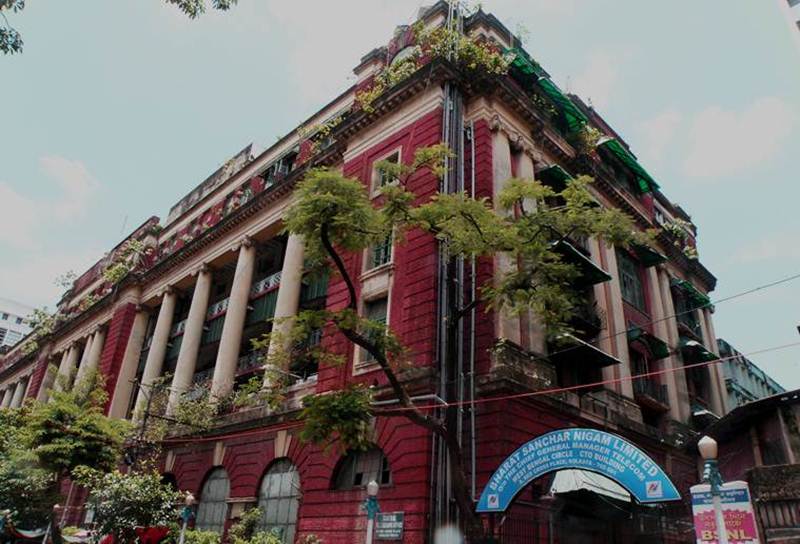 The Central Telegraph Office, Kolkata 2017 (Express Photo/ Adrija Roychowdhury)
The Central Telegraph Office, Kolkata 2017 (Express Photo/ Adrija Roychowdhury)
Today, the exquisite piece of architecture continues to be used for storing and sorting out of mail. The building also serves as the Kolkata headquarters of the Bharat Sanchar Nigam Limited (BSNL), the state owned telecommunications services in India. The top floors have been converted into a guest house for postal employees.
The General Post office
The General Post Office, overlooking Dalhousie square east, is perhaps the finest looking buildings in Kolkata today. Fifty-two year old Kanhai has been selling envelopes right beside the structure for the past 30 years now. He says his business has gone down by 50 percent now. “The GPO still functions though, but mostly for the purpose of insurance and savings,” he says.
 The General Post Office, overlooking Dalhousie square east, is perhaps the finest looking buildings in Kolkata today. (Wikimedia Commons)
The General Post Office, overlooking Dalhousie square east, is perhaps the finest looking buildings in Kolkata today. (Wikimedia Commons)
At the time the imposing piece of domed architecture was built in 1868, an elaborate machinery for postal services was being managed by the British in India. The ornate architecture cost the British a lofty sum of Rs. 6,30,510 and was particularly noted for its domed roof and the 28 corinthian pillars. The double storeyed building housed the offices of the Postmaster General and the Presidency Postmaster, both of which have now been shifted.
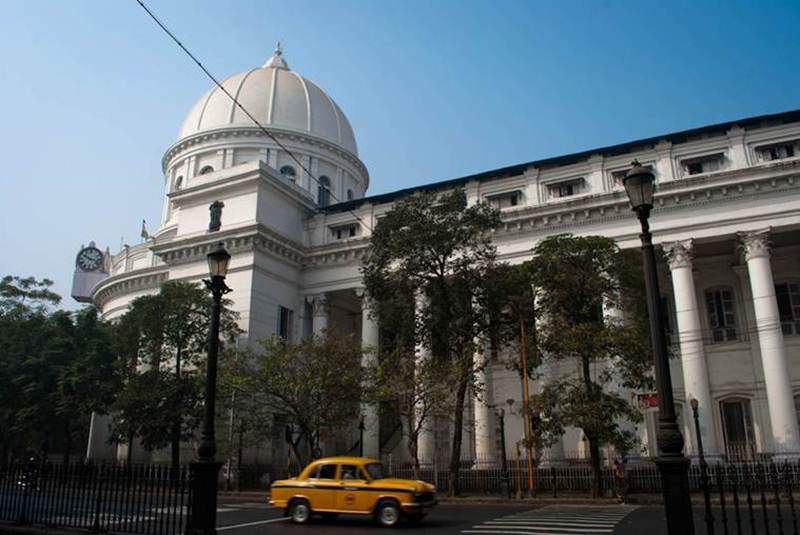 The General Post Office, Kolkata 2017 (Wikimedia Commons)
The General Post Office, Kolkata 2017 (Wikimedia Commons)
Today, the landmark building still serves as the post office in Kolkata but also houses a postal museum showcasing a large collection of artefacts and stamps.
The Great Eastern Hotel
Currently called the Lalit Great Eastern Hotel, located in Old Court House Street, is now a symbol new India’s rich and elite. In the mid nineteenth century though, the hotel was a creation of colonial pomp, popularly referred to as the “jewel in the East.” It was opened by David Wilson in 1840 and was named “Auckland Hotel” after the then governor-general of India. Colloquially though, the hackney-carriage drivers around the hotel used to refer to it as “Wilson saheb ka hotel”, the name that was used to describe the building by Rabindranath Tagore in his autobiography as well.
 The Great Eastern Hotel was opened by David Wilson in 1840 and was named “Auckland Hotel” after the then governor-general of India. (Wikimedia Commons)
The Great Eastern Hotel was opened by David Wilson in 1840 and was named “Auckland Hotel” after the then governor-general of India. (Wikimedia Commons)
The name “Great Eastern Hotel” was acquired in 1915. In its hey day, the hotel had housed some great personalities of the world like Nikita Khrushchev, Mark Twain and Elizabeth II. After independence too the hotel had retained its past glamour. Things started deteriorating for this massive piece of colonial construction during the Naxal era in Bengal.
 In its hey day, the hotel had housed some great personalities of the world like Nikita Khrushchev, Mark Twain and Elizabeth II. (Wikimedia Commons)
In its hey day, the hotel had housed some great personalities of the world like Nikita Khrushchev, Mark Twain and Elizabeth II. (Wikimedia Commons)
During the Naxal disturbance in Bengal in the 1970s, the hotel was taken over by the state and was later sold to a private group, the Lalit Hotels, Palaces and Resorts in 2005. Consequently, it went through a large amount of renovation and later opened in 2013 as both a heritage structure and a hotel for the rich and wealthy of India.
 The Great Eastern Hotel, Kolkata 2017 (Wikimedia Commons)
The Great Eastern Hotel, Kolkata 2017 (Wikimedia Commons)
St. John’s church
One of the first public spaces built by the English East India Company in Calcutta, the St. John’s church was initially the Anglican cathedral of Calcutta till 1847 when it shifted to St. Paul’s Cathedral. Built in 1787, the foundation stone of the cathedral was laid by governor-general Warren Hastings. Popularly, the edifice was also called “pathure girja” (church made of stone) on account of the fact that it was built using brick and stone in a neoclassical architectural style.
 One of the first public spaces built by the English East India Company in Calcutta, the St. John’s church was initially the Anglican cathedral of Calcutta till 1847 when it shifted to St. Paul’s Cathedral. (Wikimedia Commons)
One of the first public spaces built by the English East India Company in Calcutta, the St. John’s church was initially the Anglican cathedral of Calcutta till 1847 when it shifted to St. Paul’s Cathedral. (Wikimedia Commons)
While the church was once the prime religious spot for Company officials and other Europeans to assemble who would gather in hundreds in the church during mass services, today a mere 10-12 families frequent the church. Nonetheless, the church remains a popular heritage spot in the city, also reputed for housing the mausoleum of Job Charnock.
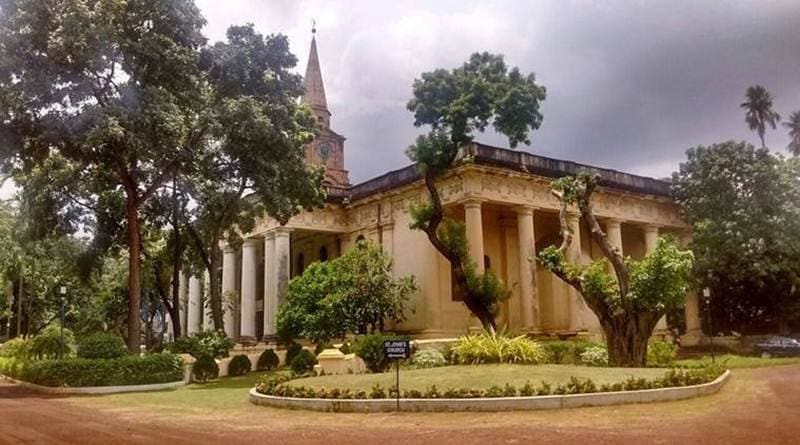 The St. John’s Church, Kolkata 2017 (Express Photo/ Adrija Roychowdhury)
The St. John’s Church, Kolkata 2017 (Express Photo/ Adrija Roychowdhury)
Apart from the structures mentioned, central Kolkata today contains several such architectural delights which were once bustling with European administrative, economic and recreational activities. Today, as the Bengal economy sees a dismal low, Kolkata continues to derive pride from a glorious past, thriving with trade activities and imperial pomp. As noted by politician, historian and writer, Evan Cotton in his reputed work, “Calcutta old and new,” “could we only shut our eyes and people Calcutta with the denizens of a century and quarter ago, what a procession of heroes and heroines would file before us.”







